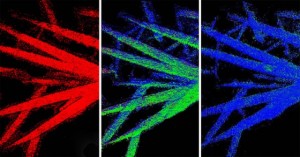
Chemical phase map showing how the electrochemical discharge of iron fluoride microwires proceeded from 0 percent discharge (left), to 50 percent (middle), to 95 percent.
Source: AZO Materials
ECS student member Linsen Li, along with former member Song Jin, have recently completed the first part of their study focusing on the powerful potential of iron fluoride in lithium-ion batteries, which can improve energy storage.
“In the past, we weren’t able to truly understand what is happening to iron fluoride during battery reactions because other battery components were getting in the way of getting a precise image,” said Linsen Li, graduate student and research assistant at the University of Wisconsin – Madison.
This development will likely impact energy storage and could, in the future, advance large-scale renewable energy storage technologies if the researchers can maximize the cycling performance and efficiency of the low-cost fluoride lithium-ion battery materials.
To understand the true potential of the new iron fluoride material, the researchers formulated an X-ray imaging method that allows scientists to observe and analyze the electrochemical reactions happening within rechargeable lithium-ion batteries containing the iron fluoride.
“Iron fluoride has the potential to triple the amount of energy a conventional lithium-ion battery can store,” said Song Jin, a UW-Madison professor of chemistry and Wisconsin Energy Institute affiliate. “However, we have yet to tap its true potential.”
One issue that scientists have faced regarding iron fluoride in rechargeable lithium-ion batteries is that of their inability to recharge properly.
This from AZO Materials:
By analyzing the alterations in iron fluoride in the batteries at the nanoscale, the researchers were able to identify each separate reaction, resulting in clear reasons for capacity decay using the newly formulated X-ray imaging method.
Another issue deals with this type of battery’s energy efficiency. However, the current research counterpoints this issue by providing alternative solutions.
The researchers also see this development transcending into other areas, such as inorganic ceramics and thin-film solar cells.
PS: Check out this meeting abstract by Li and Jin entitled, “High-Performance Lithium-ion Battery Cathodes Based on Porous FeF3 Nanowires.”

